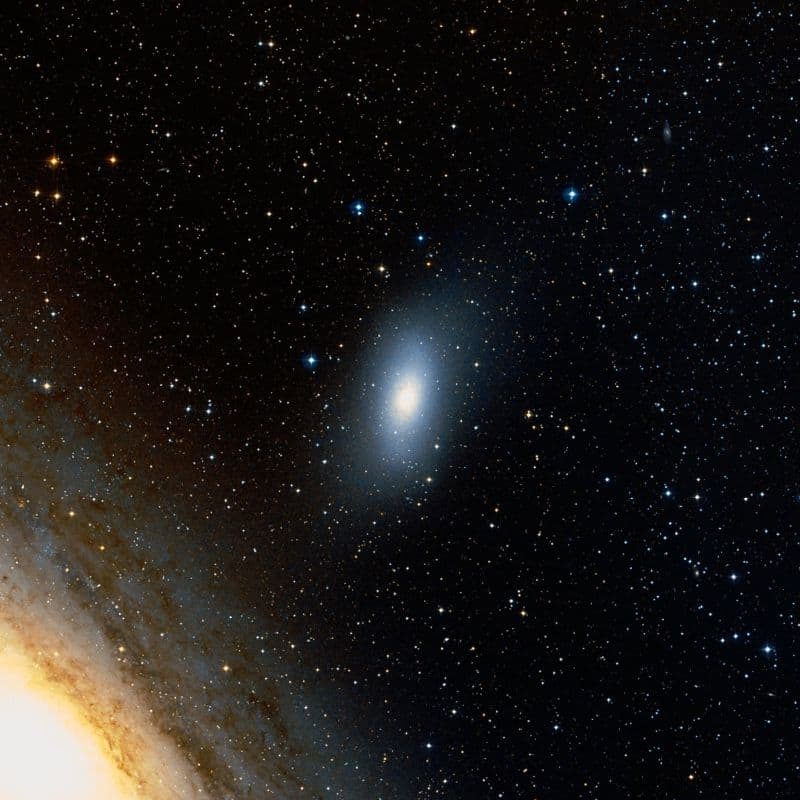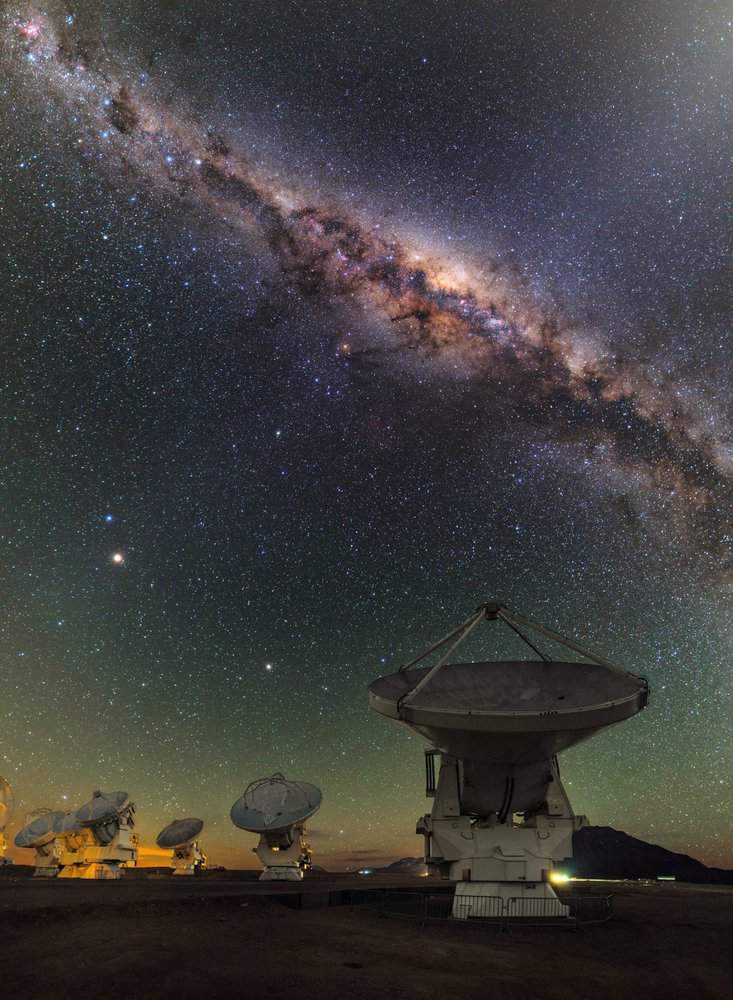Blog
The Dumbbell Nebula — also known as Messier 27 or NGC 6853 — is a typical planetary nebula and is located in the constellation Vulpecula (The Fox). The distance is rather uncertain, but is believed to be around 1,200 light-years. It was first described by the French astronomer and comet hunter Charles Messier who found it in 1764 and included it as no. 27 in his famous list of extended sky objects .Despite its class, the Dumbbell Nebula has nothing to do with planets. It consists of very rarified gas that has been ejected from the hot central star (well visible on this photo), now in one of the last evolutionary stages. The gas atoms in the nebula are excited (heated) by the intense ultraviolet radiation from this star and emit strongly at specific wavelengths.
This image is the beautiful by-product of a technical test of some FORS1 narrow-band optical interference filtres. They only allow light in a small wavelength range to pass and are used to isolate emissions from particular atoms and ions. In this three-colour composite, a short exposure was first made through a wide-band filtre registering blue light from the nebula. It was then combined with exposures through two interference filtres in the light of double-ionized oxygen atoms and atomic hydrogen. They were colour-coded as “blue”, “green” and “red”, respectively, and then combined to produce this picture that shows the structure of the nebula in “approximately true” colours.
They are three-colour composite based on two interference ([OIII] at 501 nm and 6 nm FWHM — 5 min exposure time; H-alpha at 656 nm and 6 nm FWHM — 5 min) and one broadband (Bessell B at 429 nm and 88 nm FWHM; 30 sec) filtre images, obtained on September 28, 1998, during mediocre seeing conditions (0.8 arcsec). The CCD camera has 2048 x 2048 pixels, each covering 24 x 24 µm and the sky fields shown measure 6.8 x 6.8 arcminutes and 3.5 x 3.9 arcminutes, respectively. North is up; East is left.

Jan Hammer (Czech pronunciation: [ˈjan ˈɦamɛr]) (born 17 April 1948) is a Czech-American musician, composer and record producer. He first gained his most visible audience while playing keyboards with the Mahavishnu Orchestra in the early 1970s, as well as his film scores for television and film including “Miami Vice Theme” and “Crockett’s Theme“, from the 1980s television program, Miami Vice. He has continued to work as both a musical performer and producer, expanding to producing film later in his career.
Hammer has collaborated with some of the era’s most influential jazz and rock musicians such as John McLaughlin, Jeff Beck, Al Di Meola, Mick Jagger, Carlos Santana, Stanley Clarke, Tommy Bolin, Neal Schon, Steve Lukather and Elvin Jones. He has composed and produced at least 14 original motion picture soundtracks, the music for 90 episodes of Miami Vice and 20 episodes of the television series Chancer. His compositions have won him several Grammy Awards.
Jan Hammer was born in Prague, then capital of Czechoslovakia (now the Czech Republic).
more...Charles Anthony “Buster” Williams (born April 17, 1942 in Camden, New Jersey) is an American jazz bassist. Williams is known for his membership in pianist Herbie Hancock‘s early 1970s group, working with guitarist Larry Coryell from the 1980s to present, working in the Thelonious Monk repertory band Sphere and as the accompanist of choice for many singers, including Nancy Wilson.
Williams’ father, Charles Anthony Williams, Sr., was a musician who played bass, drums, and piano, and had band rehearsals in the family home in Camden, New Jersey, exposing Williams to jazz at an early age. Williams was particularly inspired to focus on bass after hearing his father’s record of Star Dust, performed by Oscar Pettiford, and started playing in his early teens. He had his first professional gig while he was still a junior high school student, filling in for Charles, Sr., who had double booked himself one evening. Williams later spent his days practicing with Sam Dockery, who was playing in Jimmy Heath‘s band in Philadelphia on a regular double bill with Sam Reed.
https://www.youtube.com/watch?v=ecrxBezA1mc
more...Johnny St. Cyr (April 17, 1890 – June 17, 1966) was an American jazz banjoist and guitarist.
St. Cyr was born in New Orleans, Louisiana. He played for several leading New Orleans bands before moving to Chicago in 1923.[1] He is most commonly remembered as a member of Louis Armstrong’s Hot Five and Hot Seven bands. He also played with Jelly Roll Morton‘s Red Hot Peppers. He composed the popular standard “Oriental Strut“, noted for its adventurous chord sequence.
From 1961 until his death in 1966, St. Cyr was the bandleader of the Young Men from New Orleans, who performed at Disneyland. He died in Los Angeles, California, and is buried in Evergreen Cemetery, in Los Angeles.
more...Isabel Vargas Lizano (Spanish pronunciation: [tʃaˈβela ˈβaɾɣas]; 17 April 1919 – 5 August 2012), better known as Chavela Vargas, was a Costa Rica-born Mexican singer. She was especially known for her rendition of Mexican rancheras, but she is also recognized for her contribution to other genres of popular Latin American music. She was an influential interpreter in the Americas and Europe, muse to figures such as Pedro Almodóvar, hailed for her haunting performances, and called “la voz áspera de la ternura”, the rough voice of tenderness. The Latin Academy of Recording Arts & Sciences, presented her with a Latin Grammy in 2007.
She was born in Costa Rica, in San Joaquín de Flores, as Isabel Vargas Lizano, daughter of Francisco Vargas and Herminia Lizano. She was baptized on 15 July 1919 with the forenames “María Isabel Anita Carmen de Jesús.” She had a difficult childhood: her parents divorced and left her under the care of an uncle, and she contracted poliomyelitis. She went by Chavela, which is a pet name for Isabel. At age 17, she abandoned her native country due to lack of opportunities for a musical career, seeking refuge in Mexico, where an entertainment industry was burgeoning. There she resided for almost eight decades and obtained Mexican nationality.
more...The most flamenco “bulerías” are in Phrygian mode (with the I chord mutation that becomes Major perfect, often combining melodic and harmonic turns on the I and VI).
more...Messier 110 shows evidence of recent star forming activity as it contains a population of young blue stars at its centre. It also has some dust, which is unusual for a galaxy of this type and likely a result of interaction with its large neighbour, M31. M110 is classified as a peculiar elliptical galaxy because of its unusual dark structures and signs of recent star formation. The galaxy does not appear to have a supermassive black hole at its centre.
As a satellite galaxy of M31, M110 is a member of the Local Group. It is one of at least 14 dwarf galaxies orbiting Andromeda, and the second brightest of Andromeda’s satellites, after Le Gentil (M32).
Messier 110 is often catalogued as a dwarf spheroidal galaxy, which makes it the only galaxy of this type listed in the Messier Catalogue. It is, however, much brighter than other galaxies of this kind and is sometimes classified simply as a spheroidal galaxy. M110 has an estimated mass of between 4 and 15 billion solar masses.
Messier 110 is estimated to contain about 10 billion stars and has a population of at least eight globular clusters. The brightest of these, G73, is of 15th magnitude and can be seen in large amateur telescopes. 2.674 million light years distant.

John Wesley Funchess (April 16, 1931 – February 1, 1994) known professionally as John (or Johnny) Littlejohn, was an American electric blues slide guitarist. He was active on the Chicago blues circuit from the 1950s to the 1980s.
Born in Lake, Mississippi, Littlejohn first learned to play the blues from Henry Martin, a friend of his father’s. In 1946 he left home and traveled widely, spending time in Jackson, Mississippi; Arkansas; Rochester, New York; and Gary, Indiana. He settled in Gary in 1951, playing whenever possible in the nearby Chicago area. Through his connections in Gary, he was acquainted with Joe Jackson, the patriarch of the musical Jackson family, and Littlejohn and his band reputedly served as an occasional rehearsal band for the Jackson 5 in the mid- to late 1960s.
Littlejohn played regularly in Chicago clubs (he was filmed by drummer Sam Lay playing with Howlin’ Wolf‘s band about 1961) but did not make any studio recordings until 1966, when he cut singles for several record labels. Later that year he recorded an album for Arhoolie Records and four songs for Chess Records. The Chess tracks were not issued at the time.
He recorded a few singles for small local labels but did not record another album until 1985, when Rooster Blues issued So-Called Friends. Soon after, he fell into ill health. He died of renal failurein Chicago, on February 1, 1994, at the age of 62.
more...Herbert Jay Solomon (April 16, 1930 – July 1, 2003), Best known by his stage name Herbie Mann, was an American jazz flautist and important early practitioner of world music. Early in his career, he also played tenor saxophone and clarinet (including bass clarinet), but Mann was among the first jazz musicians to specialize on the flute. His most popular single was “Hijack“, which was a Billboard No. 1 dance hit for three weeks in 1975.
Mann emphasized the groove approach in his music. Mann felt that from his repertoire, the “epitome of a groove record” was Memphis Undergroundor Push Push, because the “rhythm section locked all in one perception.”
Herbie Mann was born in Brooklyn, New York, to Jewish parents, Harry C. Solomon (May 30, 1902 – May 31, 1980), who was of Russian descent, and Ruth Rose Solomon (née Brecher) (July 4, 1905 – November 11, 2004), of Romanian descent who was born in Bukovina, Austria-Hungary but immigrated to the United States with her family at the age of 6. Both of his parents were dancers and singers, as well as dance instructors later in life. He attended Lincoln High School in Brighton Beach. His first professional performance was playing the Catskills resorts at age 15. In the 1950s Mann was primarily a bop flutist, playing in combos with artists such as Phil Woods, occasionally playing bass clarinet, tenor saxophone and solo flute.
Mann was an early pioneer of the fusion of jazz and world music. In 1959, following a State Department sponsored tour of Africa, he recorded Flautista!, an album of Afro-Cuban jazz. In 1961 Mann toured Brazil, returning to the United States to record with Brazilian musicians, including Antonio Carlos Jobim and guitarist Baden Powell. These albums helped popularize bossa nova in the US and Europe. He often worked with Brazilian themes. In the mid-1960s Mann hired a young Chick Corea to play in some of his bands. In the late 1970s and early 1980s Mann played duets at New York City’s The Bottom Line and Village Gate clubs, with Sarod virtuoso Vasant Rai.
more...Bennie Green (April 16, 1923 – March 23, 1977) was an American jazz trombonist.
Born in Chicago, Illinois, Green worked in the orchestras of Earl Hines and Charlie Ventura, and recorded as bandleader through the 1950s and 1960s.[1] According to critic Scott Yanow of Allmusic, Green’s style straddled swing music and soul, making him one of the few trombonists of the 1950s and ’60s uninfluenced by the pioneering sound of J.J. Johnson.
Green relocated to Las Vegas where he played in hotel bands for the last decade of his career, though he made occasional appearances at jazz festivals. He died on March 23, 1977.
https://www.youtube.com/watch?v=fndaxqN2Yqg
more...Alton Purnell (April 16, 1911 – January 14, 1987) was an American jazz pianist. He was a longtime performer in Dixieland jazz. Purnell was born in New Orleans on April 16, 1911. His brother, Theodore, became a reed player.
Purnell sang before playing piano professionally, beginning to do so locally in New Orleans in 1928. He played in the 1930s with Isaiah Morgan, Alphonse Picou, Big Eye Louis Nelson, Sidney Desvigne, and Cousin Joe, and with Bunk Johnson in the middle of the 1940s.[2] Purnell joined George Lewis‘s band after Johnson’s broke up in 1946, and remained there well into the 1950s, including for international tours.
In 1957 Purnell relocated to Los Angeles. There he worked with Teddy Buckner, Young Men from New Orleans, Joe Darensbourg, Kid Ory, Barney Bigard, and Ben Pollack. He also recorded extensively as a leader, including for Warner Bros. Records, GHB, and Alligator Jazz. He toured internationally as a guest soloist from 1964. Purnell died in Inglewood, California on January 14, 1987.
more...This view shows several of the ALMA antennas and the central regions of the Milky Way above. In this wide field view, the zodiacal light is seen upper right and at lower left Mars is seen. Saturn is a bit higher in the sky towards the centre of the image. The image was taken during the ESO Ultra HD (UHD) Expedition. The Atacama Large Millimeter/submillimeter Array (ALMA) is an astronomical interferometer of 66 radio telescopes in the Atacama Desert of northern Chile, which observe electromagnetic radiation at millimeter and submillimeter wavelengths. The array has been constructed on the 5,000 m (16,000 ft) elevation Chajnantor plateau – near the Llano de Chajnantor Observatory and the Atacama Pathfinder Experiment. This location was chosen for its high elevation and low humidity, factors which are crucial to reduce noise and decrease signal attenuation due to Earth’s atmosphere.

Surjit Bindrakhia (born Surjit Bains; 15 April 1962 – 17 November 2003) was an Indian singer. He was known for his unique voice and hekh, in which he sings a note continuously in one breath. His biggest hits include Meri Nath Dig Paye, Dupatta Tera Satrang Da, Lakk Tunoo Tunoo, Bas Kar Bas Kar, Mukhda Dekh Ke, Tera Yaar Bolda, and Jatt Di Pasand. Surjit is considered to have one of the greatest voices in Bhangra. He received a special jury award at the 2004 Filmfare Awards for his contribution to Punjabi music.
https://www.youtube.com/watch?v=_SBjAUgCCnI
more...Roy Linwood Clark (April 15, 1933 – November 15, 2018) was an American singer and musician. He is best known for having hosted Hee Haw, a nationally televised country variety show, from 1969 to 1997. Clark was an important and influential figure in country music, both as a performer and in helping to popularize the genre.
During the 1970s, Clark frequently guest-hosted for Johnny Carson on The Tonight Show and enjoyed a 30-million viewership for Hee Haw. Clark was highly regarded and renowned as a guitarist, banjo player, and fiddler. He was skilled in the traditions of many genres, including classical guitar, country music, Latin music, bluegrass, and pop. He had hit songs as a pop vocalist (e.g., “Yesterday, When I Was Young” and “Thank God and Greyhound”), and his instrumental skill had an enormous effect on generations of bluegrass and country musicians. He became a member of the Grand Ole Opry in 1987, and, in 2009, was inducted into the Country Music Hall of Fame. He published his autobiography, My Life in Spite of Myself, in 1994. Clark was born April 15, 1933, in Meherrin, Virginia, one of five children born to Hester Linwood Clark and Lillian Clark (Oliver).
https://www.youtube.com/watch?v=YWr8EBal51Y
more...Irving Herbert Pomeroy III (April 15, 1930 – August 11, 2007) was an American jazz trumpeter, teacher, and the founder of the MIT Festival Jazz Ensemble. Pomeroy was born in Gloucester, Massachusetts, United States. He began playing trumpet at an early age. In his early teens he started performing in Boston, claiming inspiration from the music of Louis Armstrong. In 1946, at the age of 16, he became a member of the Musicians Union in Gloucester after the union did not have enough members to conduct a meeting. He studied dentistry at Harvard University for a year but dropped out to pursue his jazz career.
After high school, he studied music from 1950 to 1952 at the Schillinger House in Boston. Remaining in Boston, he played with Charlie Parker for one week in 1953, then briefly with Charlie Mariano, before going on tour with Lionel Hampton and Stan Kenton. Back in Boston, he played with Serge Chaloff and was hired to teach at Schillinger after it had been renamed the Berklee School of Music. During the latter part of the 1950s he was the leader of a sixteen-piece band which included Mariano, Bill Berry, Jaki Byard, Joe Gordon, and Boots Mussulli. For two years after that, he led another band, which included Alan Dawson, Hal Galper, Michael Gibbs, Dusko Goykovich, and Sam Rivers. He worked in pit orchestras for Broadway shows passing through Boston. Beginning in 1963 he led bands at the Massachusetts Institute of Technology. He led a band until 1993, two years before retiring from Berklee.
more...More Posts
- Bela Fleck Day
- Lee Morgan Day
- Blind Boy Fuller Day
- World Music with Omar Bashir
- Daily Roots with Owen Gray
- The Cosmos with NGC 6300
- Mitch Mitchell Day
- Colin Bailey Day
- World Music with Combo Ginebra
- Daily Roots with Freddie McGregor
- The Cosmos with IRAS 23166+1655
- Jaimoe Day
- Louis Jordan Day
- World Music with Kálmán Balogh
- Daily Roots with Johnny Clarke
- The Cosmos with NGC 1976
- Joe Zawinul Day
- Hank Mobley Day
- World Music with Russom G
- Daily Roots with Adele